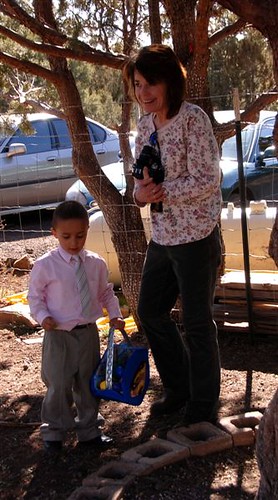Badbirdz2 is Back!
The past couple of days we have had northerlies that were not favorable for migrants attempting to cross from Cuba northward.Finally the winds have subsided and shifted to southeast, and the backlog may start to clear, just in time for the return of Pepe (BADBIRDZ2), who will interpret the radar echoes for us. This evening at about 10 PM there were simultaneous departures of moderate waves of migrants from both the north coast of Cuba and from the Keys, despite the disturbances along the Keys.. Follow this spring migration on the Badbirdz2 site.Sharing the Table: Commensalism
Close-up of the Red-breasted Merganser who led the flock along the shore (March 27, 2008)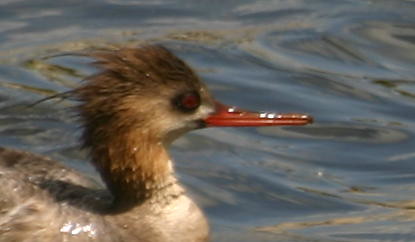
On March 25, I described how herons on our lake followed mergansers along the shore as they fished, and appeared to benefit from their proximity as fish were driven nearer the shoreline to escape the swimming predators. I have seen herons engage in similar behavior when cormorants were diving near shore. Others have related seeing herons actually attempt to grasp fish from the beaks of cormorants as they surfaced before trying to swallow them. One Florida birder saw a cormorant turn the tables and attack a Great Blue Heron that had just caught a fish.
It was almost like clockwork. As happened the first day, just as we were getting ready to eat supper, there was a commotion at the edge of the lake that caught my attention. This time there was only one merganser, with two herons, the Tricolored and the Little Blue, following along the shoreline. Again, I grabbed my camera and captured a few more images as they moved from right to left, clockwise around the lake.
The leading bird ducked its head underwater as it paddled rapidly
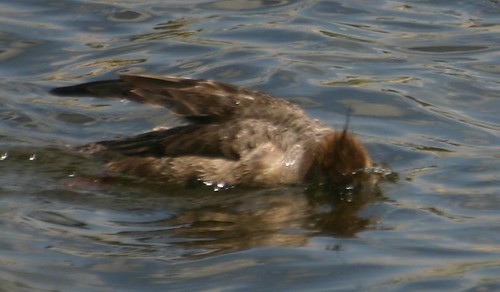
Actually, (presumably the same) five Red-breasted Mergansers, a species that I had never seen before on our little lake over four years of watching, had been out there earlier that day. Whereas on the previous day they were accompanied by a Tricolored Heron and a Snowy Egret, this time their shoreline companions were a Tricolored and a Little Blue Heron. Just as before, they were cruising along the shore with the herons following closely along.
This merganser is almost submerged in water only about 4 inches deep
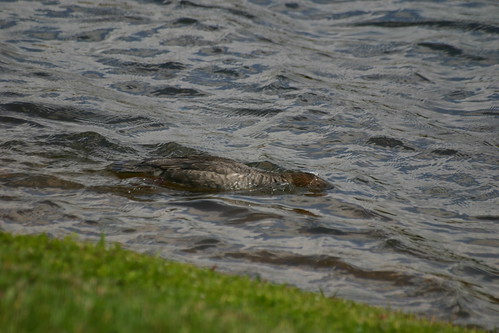
I had been hoping for a photo opportunity, but had to wait until the evening encounter, because when they were about 5 doors down from our home, the mergansers decided to move across the lake. They changed direction in unison, and the heron promptly flew across the lake as if to greet them upon arrival on the other side. Instead of immediately resuming their fishing activity, the mergansers first engaged in about 20 minutes of vigorous bathing and preening. They flapped their wings so hard that I could hear them slapping on the surface like little outboard motors, and spray flew all about (I speculated that they may have been molting and were trying to shed old feathers).
They appeared to drive a school of fish towards the shore, where three mergansers and the heron fed together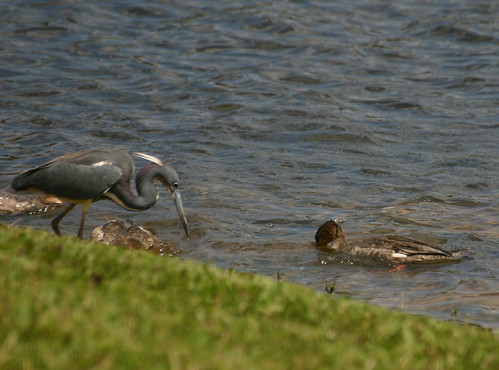
In the meantime, both herons, who only moments previously had been feverishly running along the bank and catching fish stirred up by the fish ducks, seemed content to just sit and watch the show. They also preened and even looked as if they were falling asleep, as did the the mergansers, after they hauled up on the neighbor’s lawn to bask in the early morning rays of the sun.
Why were the herons wasting their time in such a manner? It was early in the morning and the lake’s surface was quite still. It seemed to be the ideal time for them to be out catching fish on their own and not just sitting there, waiting for the mergansers to stir.
Generally, the actions of wild creatures are purposeful. What they do has meaning. They do not waste energy. To do so is not in the interest of their survival, as individuals and as a species. Humans and pet dogs commonly engage in behavior that is not purposeful. We and they can afford to do so. Critters in the wild pay dearly if they do not put every hard-earned calorie into good use.
The heron had to fly to keep up with the feeding mergansers
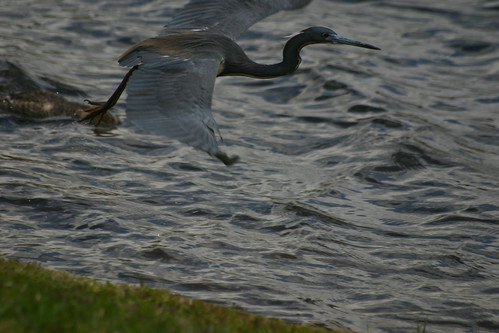
When interpreting natural history in New Mexico, I would contrast the tracks left in the sand or snow by domestic dogs with those of wild canids. Fido goes here, then there, sniffs this tree, chases his shadow or his tail, leaps into a snow drift or puddle, almost as if enjoying it. Coyote or Fox walks sedately, or trots in a straight line, directly from one place where prey may be hiding, to another, then leaps, sprints and makes a kill, or at worst, a near miss.
Students asked me how to tell the difference between dog and coyote tracks. They had to learn the “Three P’s.”
First the PRINT itself, robust, crisp and short-nailed in the coyote, but elongated and usually long-nailed and scuffed in the pet.
Second, PERFECT STEPPING; when walking, the coyote disturbs the surface of the ground, snow or leaf litter as little as possible by placing its hind foot in the same spot as its forepaw. Dogs walk a bit sideways, as if their carriage is out of alignment. Sometimes it seems their back legs want to catch up with and pass their front ones.
Finally, as mentioned, the coyote tracks show PURPOSE. They are directed at performing some survival-related task quickly and efficiently. This is not to say that wild animals do not sometimes engage in what we humans would call “play.” Yet even when coyote pups appear to be having fun, chasing and tumbling with one another, they are cementing bonds and establishing skills, rank and boundaries that will enhance their survival.
The behaviors of the herons and mergansers were related in some meaningful way. They were engaged in commensalism, meaning that the herons were deriving a benefit from the activity of the mergansers, without causing the latter any harm.It made more sense and was more efficient in terms of energy expenditure for the herons to simply wait until the ducks resumed their fishing forays along the edges of the lake.
On the morning of March 27, all five mergansers were still circling the lake, this time counterclockwise. I planned for their next pass and set up the camera. The photos on the page were all taken at that time.
This appears to be a male in non-breeding plumage
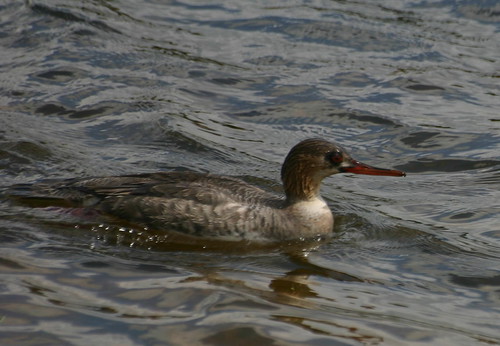
This one had a longer crest and white chest, probably another male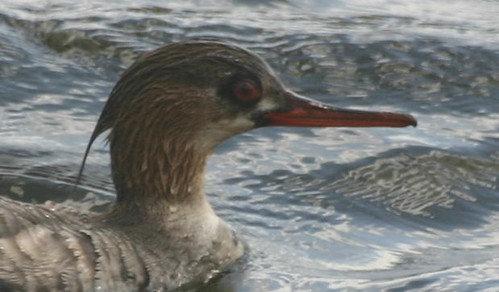
Arizona Great-Grandchildren
Just in– these are Easter pix of two of our daughter Karen’s step-grandchildren. They call her “Grandkaren.”Bella and Liam play Ring-Around-The-Rosie with “Grankaren”
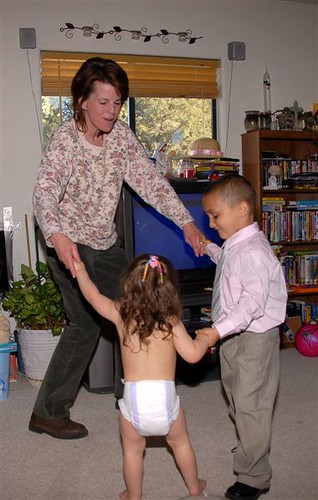
Get ready– “All fall down!”
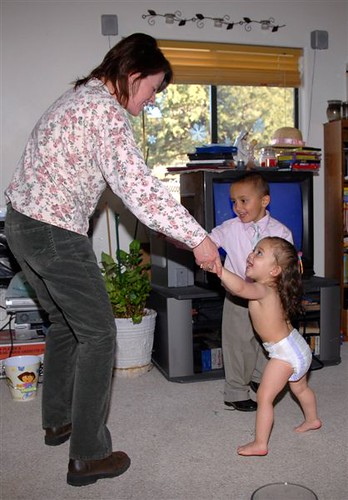
Wearing their Easter finery for an egg hunt out on the farm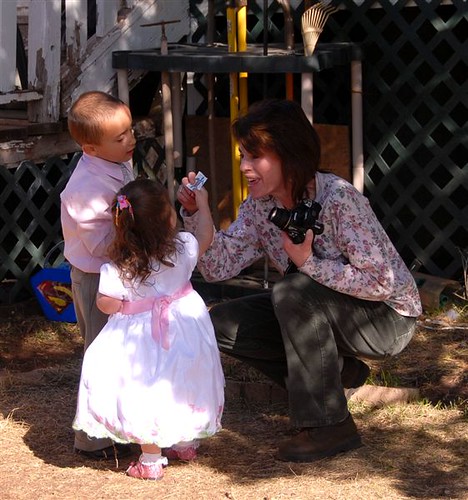
A prize for Liam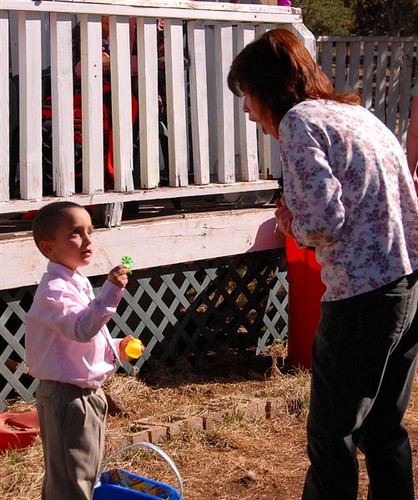
Liam has made a big egg haul! What a handsome guy!!!